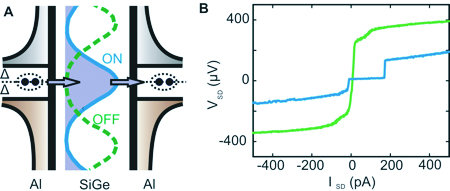In 2006, a group at Harvard university demonstrated, for the first time, a Josephson field effect transistor based on SiGe. The canal (
i.e., the junction) of the transistor was made out of a Ge/Si core/shell nanowire, and the gate voltage enabled the modulation of the observed supercurrent.
Here, we have pushed supercurrent control to the single charge level by using self-assembled SiGe nanocrystals; the area between the contacts and the dimensionality of the system are smaller than that of a nanowire. Aluminium contacts have been attached to the quantum dots by means of electron beam lithography. Cooper pair transport takes place when an energy level of the quantum dot is in resonance with the Fermi level of the electrodes. The transport being blocked outside the resonance (green curve in the figure), the device can then be switched between the superconducting and the dissipative states through a small variation of the gate voltage, on the order of 50 mV.

A) Qualitative electronic density of states versus energy for a SiGe quantum dot between aluminium contacts, characterized by a superconducting gap 2Δ. The gate voltage tunes the energy of the quantum-dot levels with respect to the Fermi energy of the leads.
B) Representative VSD(ISD) for two gate voltages. When an electronic level of the dot matches the Fermi energy (blue line) the Cooper pair tunnels between the contacts, allowing thus the flow of a supercurrent of about 200 pA. Out of resonance (green line), the transport is dissipative.